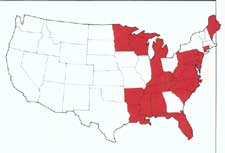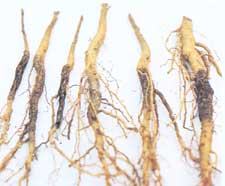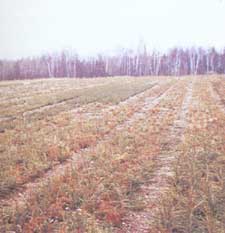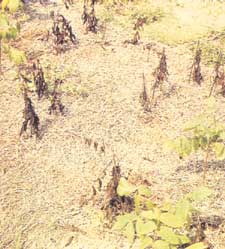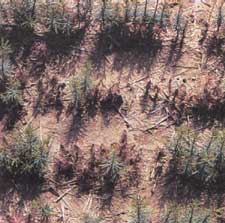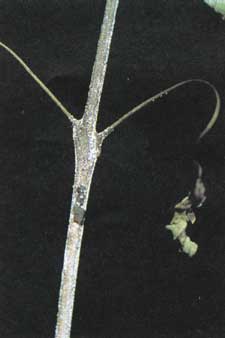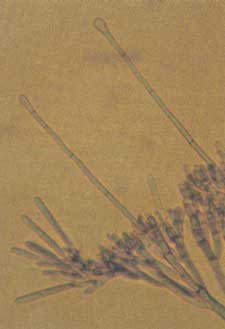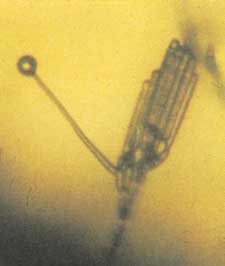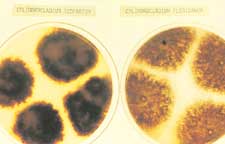Cylindrocladium DiseasesCharles E. Cordell - Plant Pathologist, Region 8, USDA Forest Service, Asheville, NC, Cordell C.E., Anderson R.L., Hoffard W.H., Landis T.D., Smith R.S. Jr., Toko H.V., 1989. Forest Nursery Pests. USDA Forest Service, Agriculture Handbook No. 680, 184 pp. Hosts Cylindrocladium diseases, caused by several species of Cylindrocladium (primarily C. scoparium, C. floridanum, and C. crotalariae), affect conifer and hardwood seedlings of many species. In the North Central and Northeastern States and in the Province of Ontario, species most commonly affected include red and eastern white pines, along with black and white spruces. In the Southern States, seedlings of black walnut, yellow-poplar, sweetgum, eucalyptus, and eastern white pine are the most commonly affected. In addition, cherrybark oak, northern red oak, dogwood, redbud, and several ornamental shrubs are susceptible. Distribution
Diagnosis Infection by species of Cylindrocladium can result in a variety of symptoms. These include pre- and postemergence damping-off, root rot, foliage blight, and stem lesions.
Stem infections on eucalyptus are frequently centered on leaf petioles. This fact suggests that infection begins in the foliage and progresses to the stems through the petioles. Foliage blight symptoms on conifers such as eastern white pine are characterized by needle discoloration (yellowing and browning, fig. 40-5), necrosis, defoliation, and subsequent seedling mortality in severe cases.
Species of Cylindrocladium readily grow on most common laboratory media. Cultures are characterized by the production of abundant tiny, reddish-brown microsclerotia (fig. 40-9). Biology Cylindrocladium spp. survive and overwinter as microsclerotia in infected plant tissues and infested soil. When seedling roots come in contact with the microsclerotia, they germinate and infection occurs. During periods of high humidity and rainfall, foliage and stem infection may also develop from infection by airborne conidia or ascospores. However, perithecia and ascospores are rarely produced in bareroot or container nurseries and have only been observed in association with C. crotalariae infections. The Cylindrocladium spp. also have the unique characteristic of tolerating a wide pH range for fungus growth and host infection. This reduces the effectiveness of nursery cultural control techniques. Control Prevention - Early detection, diagnosis, and evaluation of damage are essential. Delineate and avoid infested nursery sites as much as possible. Avoid nursery site contaminations through movement of either infected seedlings or infested soil between and within nurseries. Cultural - Favor nonhost nursery cover crops such as corn and grasses over known host cover crops such as soybeans, clover, and alfalfa. Maintain optimum nursery bed seedling densities to promote seedling aeration and growth and to reduce damage to both roots and foliage. Rogue nursery seedbeds and cull lifted material. Remove and destroy all seedlings with either discolored or wilted foliage. Cull those seedlings with 25 percent or more visible root rot damage to the taproot. Particularly for hardwood seedlings, minimize storage periods and maintain cold room storage temperatures at 35 to 40 oF. Chemical - In infested nurseries, fumigate seedbeds immediately before sowing. Special considerations may be needed for soil fumigation preceding the cover crop to provide adequate endomycorrhizae on hardwood seedlings (see the introductory chapter oti mycorrhizae). The most effective soil fumigant is a formulation of 67 percent methyl bromide and 33 percent chloropicrin. Employ deep soil fumigation (minimum of 12 in) when growing highly susceptible and deep-rooted hardwood species such as black walnut, yellow-poplar, and sweetgum. Apply foliar fungicides to prevent foliage and shoot diseases on susceptible conifer and hardwood seedlings. Benomyl and chlorothalonil have been effective for this purpose on eucalyptus seedlings in a south Florida nursery; however, special local need registrations may be required in other States. Dip seedling roots before transplanting. Dipping roots in solutions of benomyl has been effective in reducing losses from Cylindrocladium root rot on transplanted conifer seedlings in the North Central and Eastern States. Selected References Barnard, Edward L. 1984. Occurrence, impact, and fungicidal control of girdling stem cankers caused by Cylindrocladium scoporium on eucalyptus seedlings in a south Florida nursery. Plant Disease. 68: 471 -473. Cordell, Charles F. 1976. The biology of Cylindrocladium spp. in soot hem forest tree nurseries. Durham, NC: Duke University. 189 p. Ph.D. dissertation. Cordell. Charles F.; Skilling, Darroll D. 1975. Cylindrocladium root rot. In: Peterson, Glenn W.; Smith, Richard S., Jr., tech. coords. Forest nursery diseases in the United States. Agric. Handb. 470. Washington. DC: U.S. Department of Agriculture: 23-26. Thies, Walter G.; Patton, Robert F. 1970. The biology of Cylindrocladium scoparium in Wisconsin forest tree nurseries. Phytopathology. 60: 1662-1668. |
Forest Pests: Insects, Diseases & Other Damage Agents |

|
|
